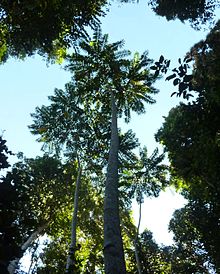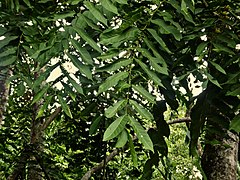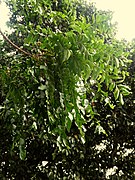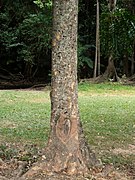| Didymocheton gaudichaudianus | |
|---|---|

| |
| Ivory mahogany near Lacey Creek, Queensland | |
| Conservation status | |
 Least Concern (IUCN 3.1) | |
| Scientific classification | |
| Kingdom: | Plantae |
| Clade: | Tracheophytes |
| Clade: | Angiosperms |
| Clade: | Eudicots |
| Clade: | Rosids |
| Order: | Sapindales |
| Family: | Meliaceae |
| Genus: | Didymocheton |
| Species: | D. gaudichaudianus |
| Binomial name | |
| Didymocheton gaudichaudianus A.Juss. | |
| Synonyms | |
List
| |
Didymocheton gaudichaudianus, commonly known as ivory mahogany, is a species of rainforest tree in the family Meliaceae, native to Malesia, Papuasia, Queensland, and some southwest Pacific islands.
Description
The ivory mahogany is a large tree growing up to 36 m (118 ft) in height with a straight trunk up to 80 cm (31 in) diameter. The bark is smooth and often has teaspoon-sized depressions in it. Buttress roots are a feature of this tree and may reach up to 2.5 m (8 ft 2 in) high and 3.5 m (11 ft) wide.
The very large leaves are produced in whorls and clustered towards the ends of the branches. They are imparipinnate with up to 14 pairs of leaflets, and measure up to 125 cm (49 in) in length. This arrangement produces large spherical clusters of foliage (see gallery).
The leaflets are highly asymmetric at the base with one side of the leaf blade wider than the other. They measure up to 30 by 8 cm (11.8 by 3.1 in)
The inflorescences are thyrses, about 70 cm (28 in) long, and produced in or close to the leaf axils. The flowers are a pale cream or green, 5-merous, with an unpleasant smell. The fruits are capsules about 3 cm (1.2 in) diameter which are covered in fine brown hairs. They have five segments and contain up to 10 seeds about 1 cm (0.39 in) long.
Phenology
Flowering in Australia occurs from September to January, with fruits ripening around October to February.
Taxonomy
This species was first described by Adrien-Henri de Jussieu in 1830. It has been known by many synonyms.
The species epithet was given to honour French botanist Charles Gaudichaud-Beaupré. The former genus name Dysoxylum comes from the Latin dys meaning "bad", and the Ancient Greek xylon meaning "wood", and refers to the unpleasant smell produced by some species.
Distribution and habitat
Didymocheton gaudichaudianus is native to central and eastern Malesia (Christmas Island, Java, the Lesser Sunda Islands, Sulawesi, Maluku Islands, and the Philippines), Papuasia (New Guinea, the Bismarck Archipelago, and the Solomon Islands), Queensland, Australia from the Cape York Peninsula to the Mary River in south east Queensland, and some islands South-West Pacific (Vanuatu, the Samoan Islands, Tonga, and Wallis and Futuna). It grows in lowland rainforest up to 300 metres elevation.
Gallery
-
 The compound leaf
The compound leaf
-
 Foliage cluster
Foliage cluster
-
 Trunk
Trunk
-
 Clusters of large pinnately compound leaves
Clusters of large pinnately compound leaves
-
 Developing fruit
Developing fruit
References
- IUCN SSC Global Tree Specialist Group & Botanic Gardens Conservation International (BGCI). (2019). "Dysoxylum gaudichaudianum". IUCN Red List of Threatened Species. 2019: e.T156217920A156217922. doi:10.2305/IUCN.UK.2019-3.RLTS.T156217920A156217922.en. Retrieved 21 June 2022.
- ^ "Didymocheton gaudichaudianus A.Juss". Plants of the World Online. Royal Botanic Gardens, Kew. 2024. Retrieved 4 March 2024.
- ^ F.A.Zich; B.P.M.Hyland; T.Whiffen; R.A.Kerrigan (2020). "Dysoxylum gaudichaudianum". Australian Tropical Rainforest Plants Edition 8 (RFK8). Centre for Australian National Biodiversity Research (CANBR), Australian Government. Retrieved 21 June 2022.
- ^ Mabberley, D.J. (2021). Sandgren, M.; Kodela, P.G. (eds.). "Dysoxylum gaudichaudianum". Flora of Australia. Australian Biological Resources Study, Department of Agriculture, Water and the Environment: Canberra. Retrieved 21 June 2022.
- "Didymocheton gaudichaudianus". iNaturalist. Retrieved 4 March 2024.
- Cooper, Wendy; Cooper, William T. (June 2004). Fruits of the Australian Tropical Rainforest. Clifton Hill, Victoria, Australia: Nokomis Editions. p. 288. ISBN 9780958174213.
External links
- View a map of recorded sightings of Dysoxylum gaudichaudianum at the Australasian Virtual Herbarium
- See images of Dysoxylum gaudichaudianum on Flickriver
| Taxon identifiers | |
|---|---|
| Didymocheton gaudichaudianus | |
| Dysoxylum gaudichaudianum |
|
- IUCN Red List least concern species
- Didymocheton
- Trees of Australia
- Flora of Christmas Island
- Flora of Java
- Flora of the Lesser Sunda Islands
- Flora of the Maluku Islands
- Flora of Papuasia
- Flora of the Philippines
- Flora of Queensland
- Flora of Samoa
- Flora of Sulawesi
- Flora of Tonga
- Flora of Vanuatu
- Flora of Wallis and Futuna
- Plants described in 1830
- Taxa named by Adrien-Henri de Jussieu